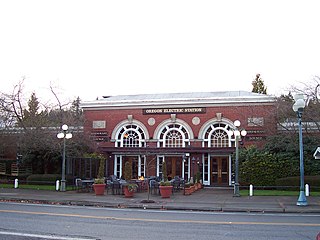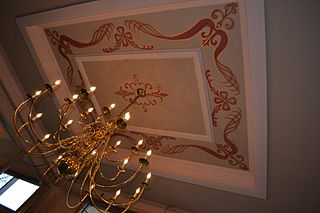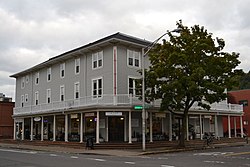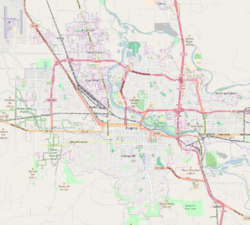
Eugene is the second largest city in the U.S. state of Oregon and the seat of Lane County. It is located at the southern end of the Willamette Valley, near the confluence of the McKenzie and Willamette rivers, about 50 miles (80 km) east of the Oregon Coast.
Palace Hotel may refer to:

The Oregon Electric Railway Passenger Station is a historic railroad station in Eugene, Oregon, United States. It was built in 1914 as a station for the Oregon Electric Railway and was designed by A. E. Doyle.

Hot Lake Hotel is a historic Colonial Revival hotel originally built in 1864 in Hot Lake, Union County, Oregon, United States. The hotel received its namesake from the thermal spring lakes on the property, and operated as a luxury resort and sanitorium during the turn of the century, advertising the medicinal attributes of the mineral water and drawing visitors worldwide. It is also the first known commercial building in the world to utilize geothermal energy as its primary heat source.

Wendling is an unincorporated community in Lane County, Oregon, United States, located northeast of Marcola. Wendling's post office operated from 1899 to 1952. It was named for George X. Wendling, a local lumberman. Wendling was created as a company town for the Booth-Kelly Lumber Company.

The Old McKenzie Fish Hatchery was used to raise trout and salmon for release into the McKenzie River in western Oregon in the United States. It is located near the unincorporated community of Vida in Lane County. The hatchery is closed, however, the historic site is now a county park. It is also listed on the National Register of Historic Places.

The Eugene Hotel is a historic hotel building in Eugene, Oregon, United States.

The Smeede Hotel, located in Eugene, Oregon, is listed on the National Register of Historic Places.

The Rice Apartments are a historic apartment building in Eugene, Oregon, United States.

Woodrow Wilson Junior High School, located in Eugene, Oregon, United States, is listed on the National Register of Historic Places. The school was constructed in 1924 on four acres at 650 West 12th Avenue near Jefferson Street for the Eugene Public School System. Architect Frederick Manson White of Portland designed the 57,120 square-foot building to accommodate 840 students. White also designed the other school built that year in Eugene, Roosevelt Junior High on Agate Street. After it opened in September 1925, Wilson became a central part of middle school education in western Eugene. In 1953, the Wilson school was converted to an elementary school and renamed Lincoln Elementary School. Aspects of the building were altered to accommodate smaller students, such as lowered blackboards and bathroom fixtures. The original twenty classrooms were reduced to fourteen, creating larger interior spaces that included administrative offices. The library was made smaller, and a storeroom and kitchen were added. After the school was closed and vacated by the school district in 1987, the building was repurposed as the Lincoln School Condominiums.

The Merchant Hotel, also known as the Merchants' Hotel, is a historic former hotel building in Portland, Oregon, United States. It is located at 121 N.W. Second Avenue in Old Town Chinatown. It is a contributing property in the Portland Skidmore/Old Town Historic District, which was listed on the U.S. National Register of Historic Places in 1975 and designated a National Historic Landmark District in 1977. It is one of the few remaining examples of Victorian Italianate, cast iron architecture on the West Coast. It occupies half of a city block, specifically along the south side of N.W. Davis Street from Second to Third Avenues.

Lord Nelson "Nels" Roney was a building contractor and carpenter working primarily in the U.S. state of Oregon. He designed and built many of Oregon's early covered bridges, often using the Howe truss. Roney also built bridges for the Oregon and California Railroad from Roseburg, Oregon south to Redding, California, and he constructed commercial buildings and houses in Eugene, Oregon.

The McMorran and Washburne Department Store Building, also known as the Tiffany Building, is a four-story commercial structure in Eugene, Oregon. The original two-story building was constructed in 1902 by Nels Roney as a dry goods store owned by former Eugene mayor J. H. McClung. The building was expanded to four stories in 1913.
Lane County History Museum, located on the county fairgrounds in Lane County in Eugene, Oregon, United States, has ongoing exhibits on the Oregon Trail, the county courthouse, historic vehicles, selections of artifacts from across the county, and photographs. The museum also provides research materials by appointment in their closed stack library, school tours, a variety of public events, and runs an annual grant program for heritage outreach projects. The museum and the Lane County Clerk's Building near the museum entrance are both administered by the Lane County Historical Society.

The main United States Post Office in Eugene, Oregon, is a 2-story Art Deco building designed by Gilbert Stanley Underwood and constructed in 1939. The front facade features blue and cream colored terracotta with black and buff colored accents, and pilasters separate multicolored window bays. The building is the only example of federal Art Deco architecture in Lane County, and it is the only federal building in Oregon to use multicolored terracotta. Murals painted by Carl Morris were installed in the lobby in 1943. The post office was added to the National Register of Historic Places in 1985. The corner at 5th and Willamette Streets contains three sites listed on the register.

















